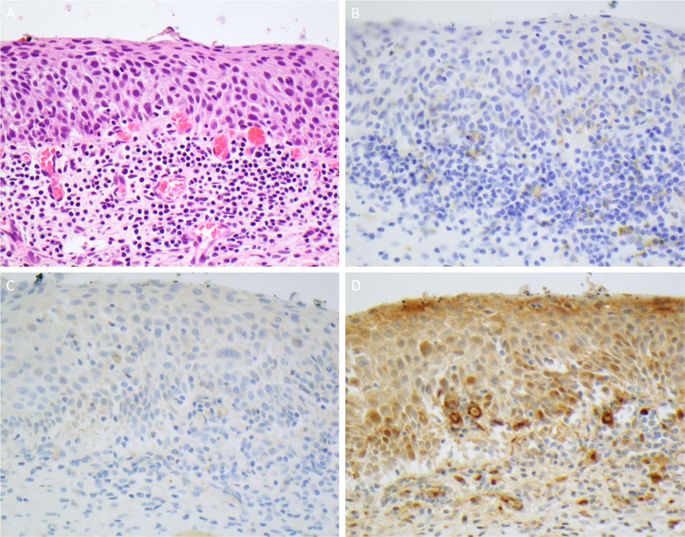Modern Pathology ( IF 7.5 ) Pub Date : 2020-03-06 , DOI: 10.1038/s41379-019-0433-3 Jacob Curley 1 , Mark R Conaway 2 , Zachary Chinn 1 , Linda Duska 3 , Mark Stoler 1 , Anne M Mills 1

|
Immunotherapies targeting the PD-1/PD-L1 pathway have shown some success in cervical and vulvar squamous cell carcinomas, but little is known about the potential vulnerability of these tumors to other checkpoint inhibitors. TIM-3 is a checkpoint molecule that exerts immunosuppressive function via its interaction with Gal-9. TIM-3 and Gal-9 have been identified on a variety of malignancies but have not been studied in cervical and vulvar cancers, nor has their relationship to PD-L1 been established. Sixty-three cervical and vulvar invasive (n = 34) and intraepithelial lesions (n = 29) were assessed for TIM-3, Gal-9, and PD-L1 in tumor/lesional cells and associated immune cells. Tumoral TIM-3 expression was identified in 85% of squamous cell carcinomas but only 21% of intraepithelial lesions (p < 0.0001). When immune cells were also accounted for, 97% of invasive and 41% of intraepithelial lesions had a TIM-3 combined positive score (CPS) ≥ 1 (p < 0.0001). Tumoral membranous expression of Gal-9 was seen in 82% of squamous cell carcinomas and 31% of intraepithelial lesions (p = 0.0001); nearly all cases had Gal-9-positive immune cells. Tumoral PD-L1 was seen in 71% of squamous cell carcinomas and 10% of intraepithelial lesions (p < 0.0001), while the PD-L1 CPS was ≥1 in 82 and 21%, respectively (p < 0.0001). There were no significant differences in TIM-3, GAL-9, or PD-L1 expression in cervical vs. vulvar neoplasms, nor was HPV status significantly associated with any of the three markers. Dual TIM-3/Gal-9 expression was present in the majority (86%) of PD-L1-positive cases including 100% of PD-L1-positive squamous cell carcinomas, suggesting a possible role for TIM-3 checkpoint inhibition in concert with anti-PD-1/PD-L1.
中文翻译:

回顾 PD-L1:免疫检查点 TIM-3 及其配体半乳糖凝集素 9 在宫颈和外阴鳞状细胞瘤中的表达。
针对 PD-1/PD-L1 通路的免疫疗法在宫颈和外阴鳞状细胞癌中取得了一些成功,但人们对这些肿瘤对其他检查点抑制剂的潜在脆弱性知之甚少。TIM-3 是一种检查点分子,通过与 Gal-9 的相互作用发挥免疫抑制功能。TIM-3 和 Gal-9 已在多种恶性肿瘤中被发现,但尚未在宫颈癌和外阴癌中进行研究,也未确定它们与 PD-L1 的关系。63 个宫颈和外阴浸润性 ( n = 34) 和上皮内病变 ( n = 29) 评估了肿瘤/病变细胞和相关免疫细胞中的 TIM-3、Gal-9 和 PD-L1。在 85% 的鳞状细胞癌中发现了肿瘤 TIM-3 表达,但在上皮内病变中仅发现了 21% ( p < 0.0001)。当免疫细胞也被考虑在内时,97% 的侵入性和 41% 的上皮内病变的 TIM-3 联合阳性评分 (CPS) ≥ 1 ( p < 0.0001)。Gal-9 的肿瘤膜表达见于 82% 的鳞状细胞癌和 31% 的上皮内病变 ( p = 0.0001);几乎所有病例都有 Gal-9 阳性免疫细胞。肿瘤 PD-L1 见于 71% 的鳞状细胞癌和 10% 的上皮内病变 ( p < 0.0001),而 PD-L1 CPS ≥ 1 的比例分别为 82% 和 21% (p < 0.0001)。宫颈肿瘤与外阴肿瘤的 TIM-3、GAL-9 或 PD-L1 表达没有显着差异,HPV 状态也与这三种标志物中的任何一种显着相关。大多数 (86%) PD-L1 阳性病例(包括 100% 的 PD-L1 阳性鳞状细胞癌)中存在双重 TIM-3/Gal-9 表达,表明 TIM-3 检查点抑制可能协同作用与抗 PD-1/PD-L1。


























 京公网安备 11010802027423号
京公网安备 11010802027423号